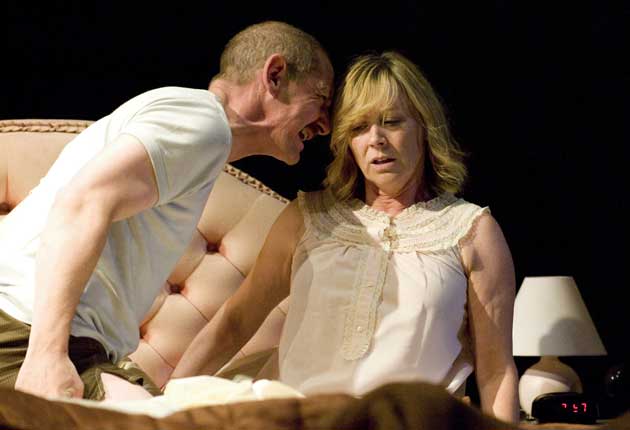Three More Sleepless Nights, National Theatre, London
Gripped by rude awakenings

Caryl Churchill's short, 50-minute 1980 play – given for just 10 performances across this month – is a polished gem (with serrated edges) of a bedroom comedy without being at all nice or comfortable. There is one large double bed, two couples, three scenes and no foreplay.
This is all "afters", and not even post-coital, just dregs of old contests and face-offs, the account at the end of the day, with a sad realization there's going to be more of the same tomorrow. I don't think Churchill is saying this is what mainly goes on in bedrooms, but it's certainly not any kind of affirmation of the joys of sex.
Who was sick over the presents at Christmas? This sounds even worse as a question than it must have been when it actually happened. Frank was pissed as usual, as he is tonight, and Margaret has just about had enough. This score-settling bust-up is the longest scene and it's ferociously well played by Lindsey Coulson as the long-suffering Margaret and Ian Hart as the defiantly drunken Frank.
Churchill, of course, is not saying Margaret's blameless (Frank certainly isn't) but nor is she saying things would be better if Frank didn't drink (though, equally obviously, they would be). We hear the stray voice of a child offstage, a reminder that resentments are left simmering when the kids are around and that going to bed is the safety valve.
In the second panel of the triptych (same bed, same neutral furnishing in Naomi Dawson's design, which sits almost snugly on the Phèdre set on the Lyttelton stage), Pete and Dawn are equally finished. He talks about movies while she gets dressed and undressed and then does something nasty with a bread knife under the bedclothes. Blood seeps through the top sheet. The uneasy elegiac quality of this scene is well caught by Paul Ready and Hattie Morahan; he recounts the contrasting velocities of Alien and The Tree of Wooden Clogs before rapping out the news that he's not seen his family for years.
Finally, Pete is in the same bedroom with Margaret from the first play. She's now got a job, or is close to getting one, and is no longer "just a wife," but Pete is still droning on about movies. He says that he's different now, and that he still bumps into Dawn. Margaret doesn't understand why he does so, and then lurches into a confession of redoubled insecurity.
Churchill says that she wanted to write about two kinds of quarrel – the one where you can't speak and the one where you both talk at once. In the first scene, she uses her characteristic over-lapping dialogue for the first time, and developed the technique in her next major play, Top Girls (1982).
She's been over-lapping like crazy ever since. It makes for quite an abrupt experience, this play, and it ends on a curious caesura in the middle of a plot summary of Apocalypse Now. That indicates the measure of her stylistic assurance but also leaves you wanting more of these not so well-known Churchill "shorts".
To 27 August (020 7452 3000; www.nationaltheatre.org.uk )
Subscribe to Independent Premium to bookmark this article
Want to bookmark your favourite articles and stories to read or reference later? Start your Independent Premium subscription today.

Join our commenting forum
Join thought-provoking conversations, follow other Independent readers and see their replies